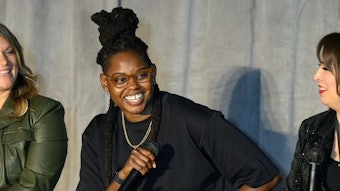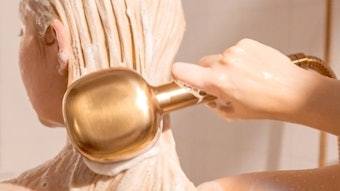
The curly cut...just reading that description and you already know that there is so much to talk about and so many different views on all the best methods. In the same breath, I know that some of you have also heard of some not savory reviews on the curly cut as well. As a celebrity curl specialist, I have been doing curly cuts on my guests since 2014, and it's still such a hot topic. Cut hair while it's curly or straightened? There's also the controversial question on whether we should cut curls when they're wet or when they're dry, but that's a different conversation that we'll circle back to a little later. For now, let’s focus on the origin of the curly cut and why it’s beneficial for those wearing their hair in a natural state. So, without further adieu, let’s dive into it.
The Origin
The origin story of the curly cut can start in a few different places. Some may say it started in the homes of curly-haired people back in the 1980s, whereas others may say the bathrooms of trusted friends, but many of the curly cut stories have started in the mecca for most fashion and beauty trends: New York.
The two most well-known curly salons in the country, DevaChan (Soho) and Ouidad's flagship salon, both happen to have started in New York. These two salons truly made an astounding mark on the early years of the “curly girl movement.” Since their genesis salons in both 1984 (Ouidad) and 1994 (DevaChan), these two powerhouse locations have defined (all puns intended) their unique versions of curly cutting techniques, product innovations, styling, education and cult followings across the globe.
Ouidad founder Ouidad Stephen Wise came up with the “carve-and-slice” technique at the first Ouidad salon. In this technique, certified professionals start their hands-on session by washing their clients first, then begin cutting on wet hair. Most guests who swear by the Ouidad approach love the fact that their curls have tons of layers, movement and a lightweight feeling after the cut is done.
DevaChan creator Lorraine Massey and Dennis DaSilva were the brainchilds of the “curl-by-curl” cutting technique, which is a completely different style. In this case, the founders really felt that cutting a clients’ hair in its dry state with little to zero tension (that’s key for this cut) would give the best outcome for their guests.
Both of these staple salons created the arena for a lot of hair stylists who wanted to specialize in curly hair emerge toward growing their clientele and to magnify the revolution of the naturally curly community. Sadly, DevaChan had to close its doors in 2022 after almost 30 years of making their clients beautiful.
A Unique Journey
Since these stylists revolutionized curly cuts, stylists began to pop up with their own curl-forward salons, suites, classes and courses across the world. When I was still in cosmetology school myself, I knew that if I was going to be in this industry. I wanted to specialize and make an impact in an area in which I both struggled and saw myself reflected. That niche for me became the exact reason why I’m a curl specialist.
My mission became about learning the techniques from the creators of these cutting styles while also cultivating my own style and approach to any curl type. Now, do you remember above when I said that we would circle back to the conversation about whether to cut hair wet vs. dry? There’s also the conversation of whether natural textures should be straightened in order to achieve a more accurate cut than the DevaChan method suggests of cutting in the natural state — dry — and also curl-by-curl. Let’s start to unpack this a bit.
Wet Vs. Dry
Both styles of cutting natural textures created by Ouidad and DevaChan are both extremely different and still unique in many ways. Although I was not trained in the Ouidad cutting techniques, I have watched many colleagues and even videos on the technique. Because their stylists cut the hair both wet and with numerous shaping and even carving techniques, their stylists and guests both stand by the results. My go to suggestion is that if it works for you and your client, then go for it! Period.
For my own training and certifications, I invested my continued education with the DevaChan and DevaCurl programs. I was taught to look at the hair in its dry state and know that where the hair “lived” was exactly where I needed to cut the hair. It just made so much sense to me and fit into my creative thought process easily. No tension. No force. Just freeform cutting and treating each curl or a small grouping of curls as uniquely as possible.
For example, if I’m looking at the back of a client’s head — the right side and then the left side — I can look at two different curls that may appear to be the same length. However, the moment that I give each of them a tug to pull them down with tension, the two patterns could not only be completely different, but also the length can reveal that as well. If my client is wearing their hair dry and in a curly state for at least 90% of the time, then I’m going to cut their hair the way that they wear it, which touches on the straightening aspect of the hair.
Straighten or Not?
I also know that there are a ton of stylists out in the world that really feel that straightening or blowing out the hair gives their clients a better shape and more accuracy with the removal of dead ends. Again, if that works for both you and the client, then hell yeah, I’m all for it!
My one thing that I want to continue to drive home for both the pro stylist as well as the guests that we care for is that there is always more than one way to be an artist. Maybe this means that you create a fusion of techniques like mixing the two above, then throwing in attributes of the Rëzo Cut method. Maybe this means that you’ve found a whole new way to go about creating more volume in the crown or a way to remove length without compromising the weight too much.
This is the time to get all of our education and techniques from the pioneers who have created before us while also simultaneously stepping into our own artistry more and more. So, no matter what methods you’ve decided to adopt in your salon space, just be sure that you not only stand in your confidence with your craft, but you’re also willing to change and adjust with the industry and your own standards. The future you will thank you.












